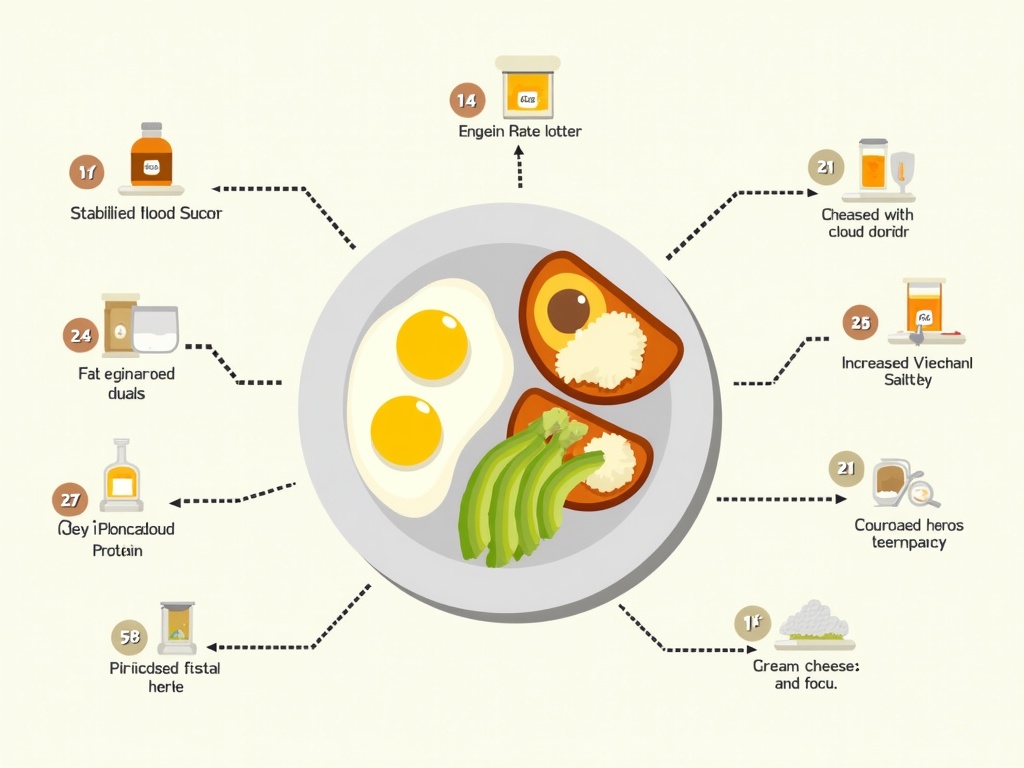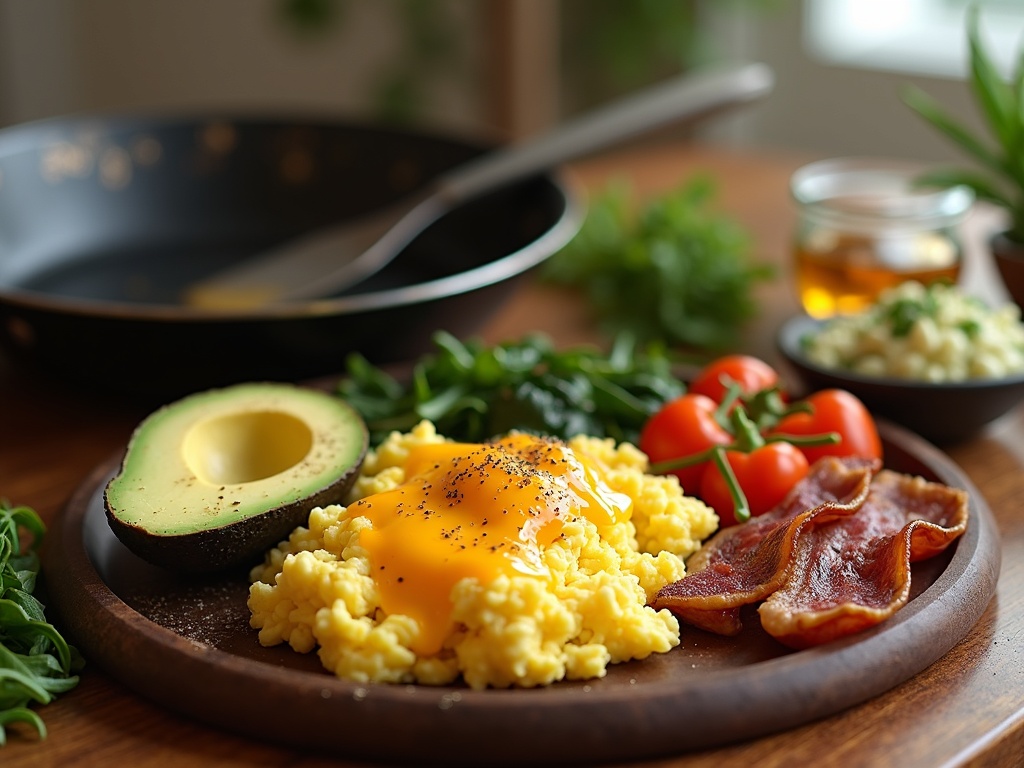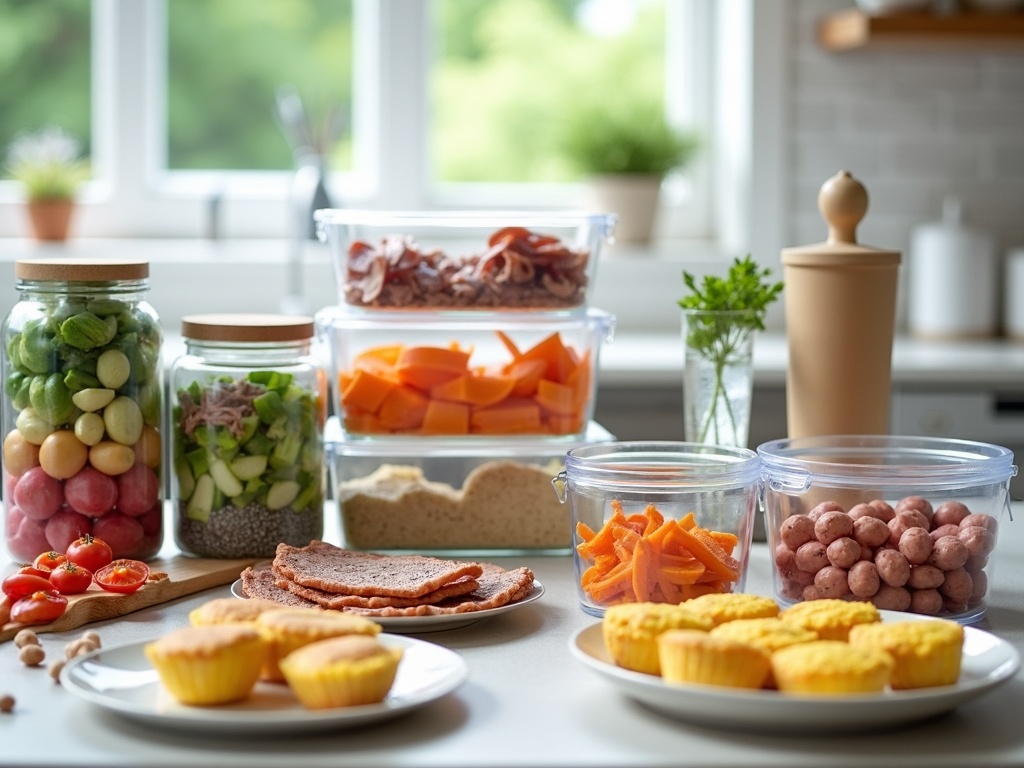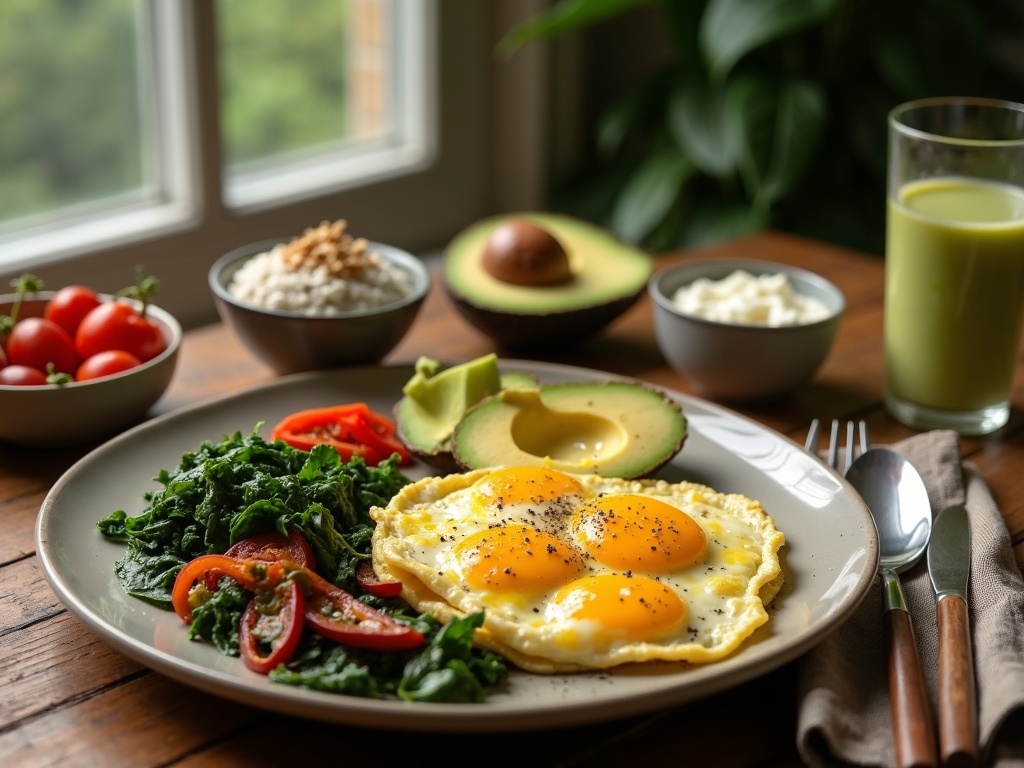A Keto Friendly breakfast jumpstarts metabolism by balancing specific macronutrients—55-60% fat, 30-35% protein, and just 5-10% carbohydrates—to activate fat-burning ketosis for faster weight loss. High-fat morning foods stabilize blood sugar, reduce hunger hormones, and provide consistent energy without dips, helping you stay on track with your diet plan throughout the day.
Find In This Article
Key Takeaways
- Eggs, avocados, and quality proteins like sugar-free bacon form the cornerstone of keto breakfasts, providing essential nutrients while maintaining low carb counts.
- A proper keto breakfast typically contains 25-30g protein, 20-25g fat, and under 5g net carbs to maintain ketosis effectively.
- Meal prepping keto breakfasts saves time and prevents dietary slip-ups during busy mornings.
- Incorporating non-starchy vegetables and small amounts of berries adds essential fiber without significantly increasing carbohydrate intake.
- Keto breakfast variations like smoothies, chia puddings, omelets, and almond flour pancakes prevent diet fatigue while maintaining ketogenic macronutrient ratios.
The Science Behind Keto Breakfast Success
I’ve discovered that understanding the science behind a ketogenic breakfast can dramatically improve your results. A properly formulated keto meal plan follows specific macronutrient ratios that trigger ketosis – the metabolic state where your body burns fat for fuel instead of carbohydrates.
Research confirms that the ideal ketogenic diet consists of 55-60% of daily calories from fat, 30-35% from protein, and just 5-10% from carbohydrates. These proportions aren’t arbitrary – they’re designed to shift your metabolism into fat-burning mode.
The weight loss benefits are impressive. Studies indicate that people following a ketogenic diet experience 2-3 times greater weight loss compared to those on low-fat diets over a 6-month period. This accelerated fat loss happens because your body becomes extremely efficient at accessing stored fat reserves when carbohydrates aren’t readily available.
Breakfast Benefits on the Ketogenic Diet
A typical keto friendly breakfast contains between 400-600 calories, but the composition of those calories matters tremendously. Here’s how a high-fat morning meal affects your body:
- Stabilizes blood sugar levels throughout the day
- Reduces hunger hormones like ghrelin
- Increases satiety hormones like peptide YY
- Provides sustained energy without crashes
- Improves mental clarity and focus
The high fat content in a protein-rich breakfast has been shown to reduce hunger and cravings throughout the day. This makes sticking to your dietary goals significantly easier, as you’re less likely to reach for carb-heavy snacks when hunger strikes.
I’ve found that incorporating various breakfast foods that fit the ketogenic framework helps maintain dietary variety. Options like eggs with avocado, cloud bread with cream cheese, or even paleo-inspired breakfasts without grains can be adapted to fit ketogenic macros.
What makes keto particularly effective is that fat provides 9 calories per gram compared to just 4 calories per gram from protein or carbs. This means high-fat foods are more energy-dense and satisfying, helping you feel full longer while consuming fewer total calories. When your breakfast incorporates this principle, you’re setting yourself up for metabolic success that lasts all day.

Essential Keto Breakfast Ingredients You Need
Starting my day with a satisfying keto breakfast keeps my energy levels stable and helps me stay on track with my low-carb lifestyle. I’ve found that stocking my kitchen with the right ingredients makes all the difference in creating delicious morning meals that maintain ketosis.
Core Keto Breakfast Components
Eggs are absolutely essential for any keto breakfast arsenal – I aim for 1-3 per serving depending on my hunger level and activity plans. They’re incredibly versatile and pack about 6g of protein each with minimal carbs. I pair them with various cheese varieties like cheddar, cream cheese, or feta to add richness and fat content without carbs.
Half an avocado provides approximately 15g of healthy fats plus fiber while adding creamy texture to any breakfast. I’ve discovered that incorporating non-starchy vegetables like spinach, bell peppers, mushrooms, and zucchini not only boosts the nutrient profile of my breakfasts but adds volume and satisfaction without significant carb impact.
The right cooking fats make a tremendous difference in keto cooking. I regularly use:
- Coconut oil for its medium-chain triglycerides that support ketosis
- Grass-fed butter for rich flavor and beneficial fatty acids
- Heavy cream for coffee, scrambles, or keto-friendly pancakes
Quality proteins form another cornerstone of my keto breakfasts. Sugar-free bacon (check labels carefully for hidden sugars) and natural sausages without fillers provide savory satisfaction and lasting energy. These protein sources help me hit my macros early in the day while keeping carbs minimal.
I enhance my breakfasts with supplementary ingredients that add texture, flavor, and nutritional benefits. A small handful of nuts like almonds or walnuts (about 1/4 cup) adds crunch and healthy fats. Seeds bring variety – I sprinkle 1-2 tablespoons of chia or flax seeds into yogurt or smoothies for omega-3 fatty acids and fiber.
For occasional sweet cravings, unsweetened cocoa powder (1-2 tablespoons) works wonderfully in high-protein breakfast recipes without adding carbs. I mix it with heavy cream and a keto-friendly sweetener for a quick chocolate mousse.
All these ingredients are specifically chosen to maintain the metabolic state of ketosis, which typically requires keeping carbohydrate intake under 50g daily (and often under 20g for strict adherence). By focusing on these fat-rich, moderate-protein, and ultra-low-carb options, I can create countless no-carb breakfast variations that keep me satisfied.
I’ve also discovered some clever ingredient substitutions that expand my breakfast options. Cauliflower makes an excellent stand-in for hash browns when properly prepared and seasoned. Almond and coconut flours replace traditional grains in cloud bread recipes and pancakes, though they behave differently than wheat flour and require adjustments to liquids and leavening agents.
For those transitioning to keto, some paleo breakfast options can overlap nicely with keto requirements. The key is selecting lower-carb fruits and starchy vegetables in modest portions.
Preparing these ingredients in advance – pre-chopping vegetables, cooking bacon, or making egg muffins – helps me stay consistent even on busy mornings. I’ve found that investing in quality storage containers extends the freshness of my keto ingredients and makes morning meal assembly much quicker.
With these essential keto ingredients on hand, I’ve transformed my morning routine from a carb-heavy habit to a satisfying ritual that supports my health goals and keeps hunger at bay for hours. The variety of breakfast foods I can create while staying keto-compliant continues to surprise me.
Creating the Perfect Keto Breakfast
I’ve discovered that starting my day with a satisfying keto breakfast sets the tone for successful low-carb eating. The perfect keto morning meal combines protein, healthy fats, and minimal carbs to keep me energized and focused until lunch.
Essential Keto Breakfast Cooking Techniques
My first step always involves heating a skillet over medium heat with a tablespoon of coconut oil or butter. This fat base is crucial for keto cooking as it adds necessary dietary fat while preventing sticking. I prefer using a non-stick or cast-iron skillet for the most reliable results – cast iron distributes heat evenly and develops a natural non-stick surface over time.
For the main component, I whip 2-3 eggs with a pinch of salt and freshly ground pepper. Eggs form the backbone of many no-carb breakfast options because they’re naturally low in carbohydrates while providing high-quality protein. The whipping incorporates air, creating fluffier eggs regardless of whether I’m making scrambled eggs, an omelet, or sunny-side up.
When cooking the eggs, I monitor them carefully and add cheese during the final minute of cooking. The residual heat melts the cheese perfectly without overcooking the eggs. Hard cheeses like cheddar or Gruyère work wonderfully for adding both flavor and the fat content essential to high protein breakfast for weight loss on keto.
Rounding Out Your Keto Breakfast Plate
The perfect keto breakfast isn’t complete without complementary sides. I serve my eggs with sliced avocado, which provides heart-healthy monounsaturated fats and essential fiber. Half an avocado typically contains only about 2 net carbs while delivering approximately 15 grams of fat – ideal macros for keto.
Adding non-starchy vegetables boosts nutritional value without significantly increasing carbohydrate intake. Spinach, mushrooms, and bell peppers are excellent choices that can be quickly sautéed in the same pan after cooking the eggs. These vegetables provide important micronutrients that might otherwise be lacking in strict paleo breakfast or keto regimens.
For extra protein and satiety, I include cooked bacon or sausage alongside the eggs. When selecting these meats, I check labels carefully to avoid hidden carbs or sugars in the processing. This protein boost helps maintain muscle mass while following a ketogenic eating plan.
The beauty of this keto breakfast formula lies in its flexibility. On days when I crave variety, I might swap traditional eggs for a cloud bread alternative topped with smashed avocado. Or I might incorporate elements of a savory oatmeal approach using cauliflower “rice” instead of oats for a warming, comforting breakfast that stays within keto parameters.
This simple yet satisfying breakfast provides approximately 25-30 grams of protein, 20-25 grams of fat, and under 5 grams of net carbs – perfect macronutrient ratios for maintaining ketosis. It keeps me full for hours and provides steady energy without the crash that comes from carb-heavy breakfast foods.
By mastering these fundamental techniques for a keto breakfast, I’ve found a sustainable morning routine that supports my low-carb lifestyle while still delivering delicious, satisfying meals to start my day right.

Delicious Keto Breakfast Variations
Starting my day with a tasty keto breakfast sets me up for success. I’ve discovered several delicious options that keep me satisfied while maintaining ketosis. These variations offer both quick daily solutions and special weekend treats that don’t compromise my low-carb lifestyle.
Satisfying Morning Meal Ideas
My go-to keto breakfast on busy mornings is a creamy Keto Avocado Smoothie. I simply blend half an avocado with a handful of fresh spinach, a cup of coconut milk, and a splash of heavy cream. This nutrient-dense drink provides healthy fats that keep me full for hours without the carb crash. Sometimes I’ll add a scoop of unflavored protein powder for an extra boost.
For meal prep enthusiasts, overnight chia pudding is a game-changer. I mix 3 tablespoons of chia seeds with unsweetened almond milk before bed, then top with crushed almonds, walnuts, or pecans in the morning. This pudding creates a satisfying texture similar to traditional breakfast porridge but with significantly fewer carbs.
Custom omelets have become my weekend specialty. I whip eggs with a bit of heavy cream for fluffiness, then fold in sautéed spinach, colorful bell peppers, and crispy bacon pieces. The versatility lets me switch up ingredients based on what’s in my fridge—sometimes I’ll add mushrooms, different cheeses, or avocado slices on top.
For special occasions or weekend treats, I make keto-friendly pancakes using almond flour and eggs as the base. The texture is slightly different from traditional pancakes, but they satisfy that comfort food craving without derailing ketosis. I often top them with a small portion of fresh berries and a dollop of unsweetened whipped cream.
What makes these breakfast options particularly practical is their storage potential. I can prepare several portions at once and store them in airtight containers for up to 3 days in the refrigerator. This advance preparation helps me stick to my low-carb breakfast goals even during hectic mornings.
I’ve found that keeping a variety of keto breakfast options in my rotation prevents diet fatigue. Some mornings call for a protein-rich breakfast like an omelet, while others might benefit from the quick convenience of an avocado smoothie. Having these alternatives ready gives me the flexibility to choose based on my daily schedule and hunger level.
The key to successful keto breakfasts lies in planning ahead and keeping keto-friendly ingredients on hand. My pantry staples now include almond flour, coconut milk, chia seeds, and various nuts, while my refrigerator always contains eggs, avocados, heavy cream, and low-carb vegetables.
For those transitioning to a paleo or keto breakfast routine, these variations offer familiar textures and flavors that make the change easier. The rich, satisfying nature of these fat-focused meals means I don’t miss the traditional carb-heavy breakfast foods I used to eat.
By keeping my morning meals simple yet delicious, I’ve made the keto lifestyle sustainable long-term. These breakfast variations provide the perfect balance of convenience, flavor, and keto-friendly macros to start my day right.
Common Keto Breakfast Pitfalls and Solutions
Protein and Carb Management
I’ve seen many people stumble on their keto journey by not including enough protein in their morning meals. Without adequate protein, you’ll feel hungry again within an hour of eating breakfast. I recommend including eggs, bacon, or high-protein breakfast options that keep you full until lunch.
Another common mistake is sneaking in high-carb ingredients without realizing it. Even “healthy” foods like bananas, honey, and traditional oatmeal can kick you out of ketosis. Instead, I suggest using berries in small amounts for sweetness or trying cloud bread as a toast alternative. Many no-carb breakfast recipes can satisfy your morning cravings without compromising your diet.
Tracking your macros is essential, especially when starting out. Apps like MyFitnessPal or Cronometer can help you monitor your carb intake and ensure you’re staying within your daily limits. I find that logging breakfast items before eating helps prevent accidental carb overload.
Adding Fiber and Fats
Many keto beginners focus so much on cutting carbs that they forget about fiber. Your body needs fiber for good digestion and sustained energy. Here are some keto-friendly ways to add fiber to your breakfast:
- Non-starchy vegetables like spinach, kale, and bell peppers in omelets
- Chia seeds or flax seeds sprinkled on paleo breakfast foods
- Avocado slices as a side or mixed into dishes
- Small portions of berries (raspberries and blackberries are lowest in carbs)
Healthy fats are the cornerstone of a proper keto diet, yet I often see people still avoiding them out of old habits. Your body needs these fats for energy and hormone production now that carbs are limited. Make sure to include olive oil, coconut oil, grass-fed butter, or ghee in your breakfast preparation.
I’ve found that breakfast foods that combine protein, fiber, and healthy fats work best for keto success. For example, an avocado egg bowl with cheese and spinach hits all the right notes without feeling restrictive.
If you’re craving something more traditional, try adapting favorite dishes like savory oatmeal alternatives made with cauliflower rice or hemp hearts. These substitutions let you enjoy familiar textures while keeping carbs in check.
Smart Storage and Meal Prep Tips
Starting a keto journey requires planning, especially when it comes to the most important meal of the day. I’ve found that having breakfast ready to go prevents those morning slip-ups when time is tight. Let me share some practical ways to store and prep your keto-friendly breakfast options that’ll save you time and keep you on track.
Prepping Like a Pro
The key to consistent keto success lies in preparation. I recommend setting aside an hour or two on weekends to get organized for the week ahead. Here’s how I make it work:
- Chop and portion vegetables for omelets and frittatas
- Pre-cook and refrigerate bacon or sausage patties for quick reheating
- Mix dry ingredients for keto pancakes in labeled containers
- Prepare egg muffins that can be refrigerated and eaten throughout the week
- Blend and freeze portions of keto smoothies (minus liquid base)
- Make a batch of cloud bread for quick breakfast sandwiches
The beauty of this approach is that when morning comes, I’m just assembling or reheating rather than starting from scratch. For those particularly hectic mornings, having no-carb breakfast options ready to grab can be a real lifesaver.
Storage Solutions That Maintain Freshness
Proper storage makes all the difference in maintaining the quality and safety of your prepped foods. I’ve learned that investing in good quality containers isn’t just about organization—it directly impacts the freshness and taste of your meals.
Glass containers work best for most keto breakfasts as they don’t absorb odors or stain. For items like avocados or cut vegetables, I use containers with separate compartments to keep ingredients fresh until serving time. This works especially well for high-protein breakfast bowls where you want to combine items just before eating.
When storing cooked eggs or meat dishes, always cool them completely before refrigerating. This prevents condensation that can make food soggy. For freezer storage, I wrap items individually before placing them in containers to prevent freezer burn. Most prepared keto breakfasts keep well for 3-4 days in the refrigerator or up to a month in the freezer.
Temperature matters too—I keep my refrigerator at or below 40°F to ensure food safety. When it’s time to reheat, make sure everything reaches at least 165°F, especially with egg-based dishes.
For those who enjoy paleo breakfast options that overlap with keto, the same storage principles apply. I’ve found that keeping herbs like parsley or chives in a glass of water in the refrigerator extends their life significantly, perfect for garnishing savory breakfast dishes.
Batch cooking has transformed my keto experience. I regularly make large portions of keto-friendly breakfast casseroles or egg bakes on Sundays, portion them into individual containers, and have breakfast sorted for the entire week. This approach not only saves time but also removes decision fatigue from busy mornings.
For grab-and-go options, I prepare overnight chia puddings in small jars or pack portions of nuts and cheese with boiled eggs. Having these ready means I’m never caught off guard, even on the busiest days.
By implementing these storage and prep strategies, I’ve found that staying keto becomes much more manageable, even during hectic workweeks. The initial time investment pays dividends in consistency, reduced food waste, and the peace of mind that comes with knowing healthy options are always at hand.

Sources:
Diabetes & Metabolism Journal, Ketogenic Diet Effects
Obesity Reviews, Dietary Intervention Strategies
Nutrition & Metabolism, Effects of Different Diets

